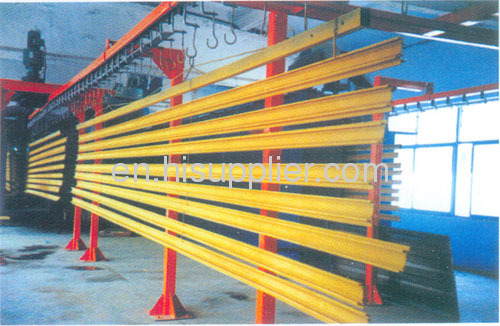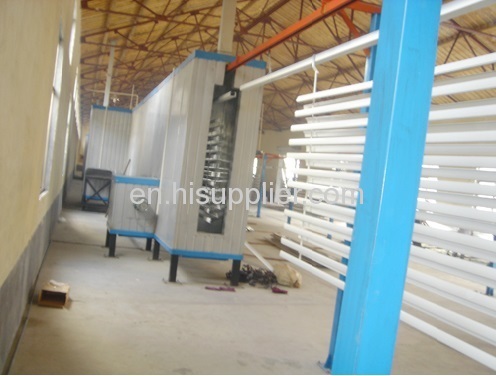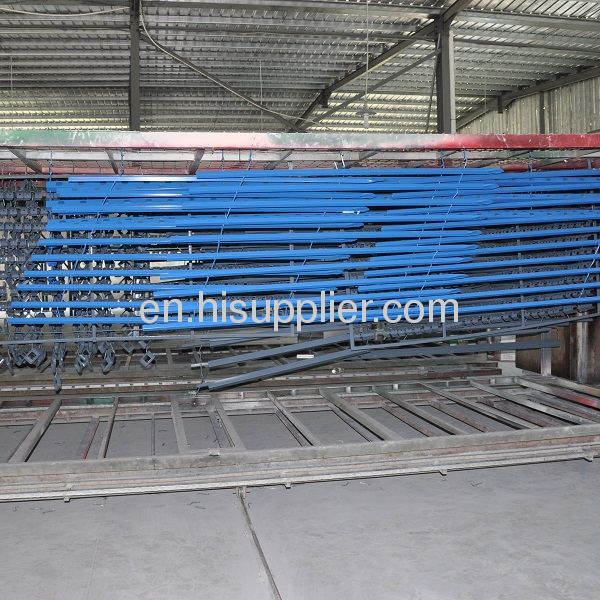1.High-efficiency powder recycle
2.Low energy consumption
3.Convenient color change
4.Full automatic control
5.High productivity
6.Small area occupation




Powder coating is a dry finishing process,using finely ground particlesof pigment andresin that are generallyelectrostatically charged andsprayed ontoelectrically grounded parts.The charged powder particlesadhere to theparts and are held there untilmelted and fused into asmooth coating ina curing oven. Before coating,the parts to be coatedare firstpretreated similarly to conventionalliquid coated parts.Thepretreatment process is normally conducted inseries with thecoatingand curing operatios.
Thereis essentially two common ways ofapplyingpowder coating: byelectrostatic spray and by fluidized bedpowdercoating. There areseveral other processes that have beendeveloped, butthey are far lessused. These include flame spraying,spraying with aplasma gun, airlesshot spray, and coating byelectophoretic deposition.
To get an overview of the technology used in the powder coating industry click on the items below:
- pretreatment
- Electrostatic Spray
- curing
Pretreatment.
Phosphating,or conversion coating, istheapplication of an iron or zinc phosphatecoating to thesubstrate.Conversion coating can be a very critical partof thepretreatmentprocess, adding significantly to the performance ofthefinished coating.A phosphate coating converts the metal substrateto auniform, inertsurface, which improves bonding, minimizes thespread ofoxidation if thecoating is scratchedand improves the overallcorrosionresistance of thefinal part.
Aconversion coating can be iron,zinc,polycrystalline, chromate, ormanganese phosphate film. Theyaredeveloped on both ferrous (ironbased) and non-ferrous surfaces(zinc,aluminum, terne and manganese).Parts are subjected to an acidicbath anda chemical conversion forms acomplete film on the partsurface,changing the chemical and physicalnature of the metal surface.
Henkelhas introduced a big breakthrough insurfacetreatment: Bonderite NT –a new surface pretreatment whichisconsiderably more efficient, lesscomplicated and morecost-effectivethan conventional iron phosphating
Electrostatic Spray
Electrostatic spray
powder coating uses apowder-airmixture from a small fluidized bed in a powder feed hopper.Insomecases, the feed hoppers vibrate to help prevent clogging orclumpingofpowders prior to entry into the transport lines. The powderissuppliedby a hose to the spray gun, which has a charged electrode inthenozzlefed by a high voltage dc power.
Electrostaticpowder spray guns direct theflow ofpowder; control the depositionrate; control the pattern size,shape, anddensity of the spray; andcharge the powder being sprayed .Thesprayguns can be manual(hand-held) or automatic, fixed or reciprocating,andmounted on one orboth sides of a conveyorized spray booth.Electrostaticspray powdercoating operations use collectors to reclaimover-spray.This reclaimedpowder is then reused, adding significantly tothe powdercoating's high transfer efficiency.
Thereare various gun designs that mainlydiffer inthe method of applyingelectrostatic charge to the powder. Insome cases,the powder iselectrostatically charged by friction. Theadvantage isthat the powderis free to deposit in an even layer over theentiresurface of the part,and deposition into recesses is improved.
The film thickness is dependent on thepowderchemistry, preheat temperature, and dwell time. Film thicknessesof (40 -60 µm) in case of plain powder ( 80 – 100 µm) in case of texturecangenerally be applied on products.
Curing
Whena thermoset powder is exposed toelevatedtemperature, it begins tomelt, flows out, and then chemicallyreacts toform a higher molecularweight polymer in a network-likestructure. Thiscure process, calledcross linking, requires a certaindegree oftemperature for a certainlength of time in order to reach fullcure andestablish the full filmproperties for which the material wasdesigned.Normally the powderscure at 200°C (390°F) in 10 minutes. Thecuringschedule could vary according to the manufacturer'sspecifications.
The application of energy to the product to be cured can be accomplished by convection cure ovens or infrared cure ovens.






